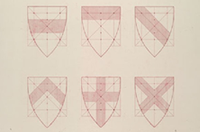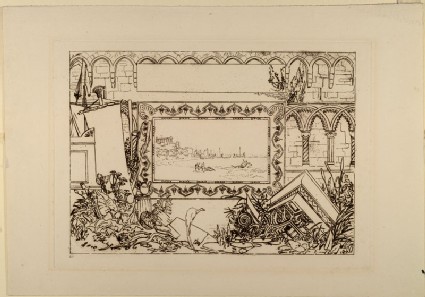Ruskin's revision to the Rudimentary series (1878)
Unpublished manuscript catalogue for proposed re-organisation of the Rudimentary series.

Ruskin's Catalogues: 1 object
Show search help- Reference URL
Actions
The Frontispiece of the Liber Studiorum Turner
-
Ruskin text
151.Frontispiece Etching Begins the series of xxv examples chosen from the Liber Studorium, with the etching from the Frontispiece entirely by his own hand and showing, more clearly than the finished plate, the materials of which he meant the work to be composed. An epitome of what the xixth.. century had to meditate on; viz. Classical Architecture, fallen, Norman Architecture, standing, with Gothic above it, confusion of Rustic or familiar objects surrounding these, and a Picture in the centre into which all these are supposed to be combined as the End of their existence - the whole signed and symbolised, as it were, by the Peacock in its character of Phoenix, or Resuscitation. In this accumulation of object it is interesting to trace what were the most important materials in Turner’s own mind; but it is not easy to understand the meaning of the caduceus of Hermes in the group of dock-leaves and thistles, nor why so great importance should be attached to Fish, while we have only one Bird and no Beasts. The etching is all by Turner’s own hand, and in his finest manner. The subject of the central Picture The rape of Europa, the mast and yard of the lateral sail antique .
-
Details
- Artist/maker
-
Turner (Joseph Mallord William Turner) (1775 - 1851) (designer, etcher)
- Object type
- Material and technique
- etching on paper
- Dimensions
- 210 x 292 mm (plate); 273 x 387 mm (sheet)
- Inscription
- Verso:
bottom left in graphite: 2.d State
bottom left, the Ruskin School's stamp
just below, in ink: T.11
- Provenance
-
Presumably presented by John Ruskin to the Ruskin Drawing School (University of Oxford); first recorded in the Ruskin Drawing School in 1878; transferred from the Ruskin Drawing School to the Ashmolean Museum c.1949
- No. of items
- 1
- Accession no.
- WA.RS.RUD.151
-
Subject terms allocated by curators:
Subjects
-
References in which this object is cited include:
References
Finberg, Alexander J., The History of Turner's Liber Studiorum: With a New Catalogue Raisonné (London: Ernest Benn, 1924), no. 01.E.II
Ruskin, John, ‘Rudimentary Series 1878’, 1878, Oxford, Oxford University Archives, cat. Rudimentary no. 151
Ruskin, John, ‘The Ruskin Art Collection at Oxford: Catalogues, Notes and Instructions’, Edward T. Cook and Alexander Wedderburn, eds, The Works of John Ruskin: Library Edition, 39 (London: George Allen, 1903-1912), 21, cat. Rudimentary no. 151
Location
-
- Western Art Print Room
Ruskin's Catalogues
-
Ruskin's revision to the Rudimentary series (1878)
151.Frontispiece Etching Begins the series of xxv examples chosen from the Liber Studorium, with the etching from the Frontispiece entirely by his own hand and showing, more clearly than the finished plate, the materials of which he meant the work to be composed. An epitome of what the xixth.. century had to meditate on; viz. Classical Architecture, fallen, Norman Architecture, standing, with Gothic above it, confusion of Rustic or familiar objects surrounding these, and a Picture in the centre into which all these are supposed to be combined as the End of their existence - the whole signed and symbolised, as it were, by the Peacock in its character of Phoenix, or Resuscitation. In this accumulation of object it is interesting to trace what were the most important materials in Turner’s own mind; but it is not easy to understand the meaning of the caduceus of Hermes in the group of dock-leaves and thistles, nor why so great importance should be attached to Fish, while we have only one Bird and no Beasts. The etching is all by Turner’s own hand, and in his finest manner. The subject of the central Picture The rape of Europa, the mast and yard of the lateral sail antique .





